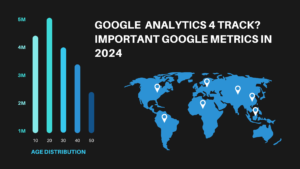
How to set up Google Analytics
Google Analytics 4 Track? Important Google Metrics in 2024 Creating exceptional content takes time and effort, and naturally, you want to know how well it’s

Welcome to the ultimate guide to digital marketing. In today’s fast-paced and digital-driven world having a strong online presence is essential for any business or individual looking to succeed. Digital marketing strategies have become a powerful tool for reaching a vast audience, promoting products and services, and increasing brand awareness. If you’re looking to skyrocket your online presence and stay ahead of the competition then this comprehensive guide is worth reading. We’ll explore various digital marketing techniques, delve into different types of digital marketing, and provide actionable tips to help you formulate successful marketing strategies. Let’s get started!
SEO, or search engine optimization, is the process of enhancing your website’s visibility in search engine results to drive organic traffic. In today’s digital world, where search engines like Google play a significant role in consumer behavior, having a well-optimized website is crucial for online success.
When users search for products or services related to your business, you want your website to appear on the first page of search results. This is where SEO comes in. By strategically incorporating relevant keywords, optimizing your website’s structure, and creating high-quality content, you increase your chances of ranking higher in search results.
Understanding how search engines work is vital to devising an effective SEO strategy. Search engines use complex algorithms to evaluate websites and determine their relevance to specific search queries. They consider factors like the quality of content, user experience, backlinks, and social signals.
To improve your website’s on-page SEO, focus on elements like title tags, meta descriptions, heading tags, and keyword usage. Including relevant keywords in your content naturally is essential, but avoid keyword stuffing, as it may harm your ranking.
While organic traffic through SEO is crucial, remember that SEO is an ongoing process. Regularly update your content, monitor your website’s performance, and adapt your strategy to stay ahead of changing search engine algorithms.
Email marketing remains one of the most effective digital marketing channels for building strong customer relationships. It allows you to directly communicate with your audience, providing them with valuable information, offers, and updates.
One of the key advantages of email marketing is its personalization and segmentation capabilities. By understanding your audience and dividing them into relevant segments, you can tailor your emails to their specific interests and needs. Personalized emails lead to higher engagement rates and ultimately foster customer loyalty.
To run successful email campaigns, focus on crafting compelling subject lines that encourage recipients to open your emails. The content should be relevant, engaging, and well-formatted. Include clear calls-to-action (CTAs) to direct users to your website or encourage them to take specific actions.
It’s essential to analyze the performance of your email campaigns using analytics tools. Monitoring metrics such as open rates, click-through rates (CTR), and conversion rates helps you understand what resonates with your audience and optimize future campaigns accordingly.
In today’s digital landscape social media marketing plays a central role in connecting businesses with their audience. Platforms like Facebook, Instagram, Twitter, and LinkedIn offer unparalleled opportunities to engage with potential customers, promote products and services, and build a brand identity.
Choosing the right social media channels for your business depends on your target audience and the nature of your products or services. For visual-based content, platforms like Instagram and Pinterest are ideal while LinkedIn is more suited for B2B interactions.
The creation of excellent content is crucial to be successful on Social Media. The variety of content such as photographs, videos and written posts keep your audience interested. To increase visibility and to target an audience larger than yourself use hashtags and relevant keywords.
Social media advertising is another powerful tool in your marketing arsenal. Paid ads allow you to target specific demographics and targeted audiences increasing the chances of reaching potential customers who may not have found your brand through organic means. The ability to set specific budget limits and measure the performance of your ads makes social media advertising a cost-effective and efficient marketing strategy.
To ensure your social media marketing efforts yield the desired results monitor key performance metrics like engagement rates, follower growth, and click-through rates. Use the data to refine your strategy and deliver content that resonates with your audience.
Content marketing has emerged as a powerful fuel for driving digital strategies. It revolves around creating and distributing valuable, relevant, and consistent content to attract and engage a specific target audience. The goal is not just to promote products or services directly but to establish trust and authority in your industry.
A well-defined content marketing strategy begins with understanding your target audience and their pain points. Create content that addresses these pain points, offers solutions, and provides insights that add value to the reader’s life.
The content you create can take various forms, including blog posts, articles, videos, infographics, and podcasts. By diversifying your content types, you can cater to different preferences and engage with a broader audience.
Promotion is a critical aspect of content marketing. Share your content across multiple digital channels, including social media, email newsletters, and other online communities relevant to your industry. Building a strong distribution network ensures that your content reaches a larger audience.
Content marketing goes hand-in-hand with SEO. By creating high-quality, valuable content, you increase the likelihood of attracting backlinks from authoritative websites, which, in turn, enhances your website’s overall SEO.
Marketing campaigns are targeted, time-limited promotional efforts designed to achieve specific business goals. They play a crucial role in digital marketing by providing a focused approach to driving desired outcomes.
When planning a marketing campaign, start by defining clear objectives. Are you aiming to boost sales, increase brand awareness, or launch a new product? Understanding your goals will guide the rest of your campaign strategy.
To create an effective marketing campaign, identify your target audience and tailor your messaging to resonate with them. Utilize different digital channels to reach your audience, ensuring consistency in your branding and messaging across all platforms.
Campaign success hinges on monitoring and analyzing key performance indicators (KPIs). Track metrics like click-through rates, conversion rates, and return on investment (ROI) to assess the campaign’s impact and identify areas for improvement.
Case studies of successful digital marketing campaigns can provide valuable insights and inspiration for your own initiatives. Analyze past campaigns from your industry and learn from both their achievements and any missteps.
Mobile marketing is a vital aspect of digital marketing, considering the widespread use of smartphones and mobile devices. To effectively reach your audience on-the-go, it’s essential to tailor your marketing efforts to suit mobile users’ preferences.
Understand your audience’s mobile behavior and preferences to create mobile-friendly experiences. Ensure your website is responsive, adapting seamlessly to various screen sizes, and optimize loading times for faster access on mobile devices.
Mobile apps present an excellent opportunity to engage with customers and offer personalized experiences. Develop an app that aligns with your brand and provides value to users, whether through exclusive content or seamless shopping experiences.
Push notifications are an effective way to keep your audience informed about new products, promotions, or updates. However, use them judiciously and avoid overwhelming users with excessive notifications.
Regularly analyze mobile marketing metrics, such as app downloads, usage patterns, and conversion rates. Understanding how users interact with your mobile offerings will help you refine your mobile marketing strategy and deliver a better user experience.
Traditional marketing and digital marketing each have their unique strengths, and finding the right balance between the two is crucial for maximizing your marketing efforts.
Traditional marketing encompasses traditional advertising methods like print media, television commercials, radio spots, billboards, and direct mail. It has been a staple of marketing for decades and can be effective in reaching local audiences or specific demographics.
On the other hand, digital marketing leverages digital channels to promote products and services. It offers greater reach, cost-effectiveness, and the ability to target specific audiences with precision.
Understanding when to use traditional marketing and when to prioritize digital marketing depends on various factors, including your target audience, budget, and marketing objectives. A combination of both can often yield the best results, allowing you to reach a broader audience while maintaining personalized and targeted digital efforts.
For instance, for local businesses targeting a specific geographical area, traditional marketing may be more effective in driving foot traffic. Simultaneously, digital marketing can help establish an online presence and attract customers from a broader region.
Businesses can extend their reach, maintain consistent messaging, and adapt their strategies to a changing marketing landscape by strategically combining traditional and digital marketing.
Affiliate marketing is a performance-based marketing strategy where businesses reward affiliates (partners) for driving traffic or sales to their websites. This collaborative approach allows businesses to leverage the reach and influence of affiliates to reach a broader audience.
When implementing an affiliate marketing program, it’s crucial to identify affiliates who align with your brand values and have a relevant audience. Partnerships that feel authentic are more likely to resonate with the affiliate’s audience and lead to higher conversions.
Offering attractive incentives, such as commissions or discounts, motivates affiliates to promote your products or services actively. Clear communication and support from your end can also strengthen affiliate relationships.
Track and measure affiliate performance using unique affiliate links or codes. This allows you to attribute sales or traffic accurately and reward affiliates based on their contributions.
Affiliate marketing is an excellent complement to your broader marketing strategy. It can drive additional revenue, increase brand visibility, and help you reach new audiences.
Your digital presence is the sum of all your online activities, including your website, social media profiles, and any other online interactions with your audience. Having a strong digital presence is essential for businesses looking to thrive in today’s digital age.
To improve your digital presence, focus on building a cohesive brand image across all digital channels. Consistency in messaging, branding, and design helps create a unified and memorable experience for your audience.
Social media plays a significant role in enhancing digital presence. Engage with your audience on social media platforms, respond to comments and messages promptly, and share valuable content that encourages interactions and shares.
Managing your online reputation is crucial for maintaining a positive digital presence. Monitor online reviews and respond to both positive and negative feedback professionally and courteously.
Search engine optimization (SEO) also plays a vital role in enhancing digital presence. By optimizing your website and content for relevant keywords, you increase your chances of ranking higher in search engine results, attracting more organic traffic.98
Engaging in online communities and forums related to your industry allows you to showcase your expertise and connect with potential customers. Provide valuable insights, answer questions, and establish yourself as a credible authority in your field.
Consistently analyze and measure your digital efforts to understand what is working and what needs improvement. Monitor website traffic, social media metrics, and online interactions to gauge the impact of your digital presence.
Remember that building a strong digital presence takes time and effort. Stay committed to creating valuable content, engaging with your audience, and adapting your strategies based on feedback and data.

Google Analytics 4 Track? Important Google Metrics in 2024 Creating exceptional content takes time and effort, and naturally, you want to know how well it’s

You’ve probably heard about the recent buzz surrounding the Google search algorithm leak and are curious about its potential implications. While some may advise caution,
© 2023 All rights reserved
Made with ❤ Swafoo Inc